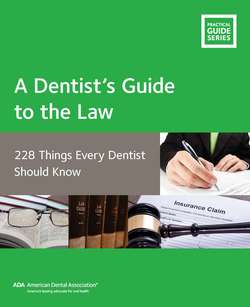Читать книгу A Dentist’s Guide to the Law - American Dental Association - Страница 69
На сайте Литреса книга снята с продажи.
36. Can I Use ADA Materials or Other Existing Material in Promoting My Practice?
ОглавлениеUsing material created by and belonging to others may be possible, depending on what you want to use, how you want to use it and whether you obtain permission as required by law.
Let’s take a specific example. Say you come across an article on a dental development and you want to place the article on your website — it’s good information, and you think it might impress your patients or attract new ones. It is likely that someone, probably the author or publisher, holds the copyright to that article. This is true whether or not the copyright owner has affixed a copyright notice to the article. To reprint the article in full, you will probably need permission from the copyright owner. It is best to secure written permission allowing you to copy the work and use it when, how, and where you want to. Failure to obtain such permission would in most cases be a violation of federal law.
The following works — published or unpublished — are generally covered by U.S. and international copyright laws:
• Text (written works of fiction and non-fiction)
• Musical materials (songs and musical compositions)
• Visual images and materials (illustrations, photographs, and Web page graphics)
Copyright laws make it illegal to use or copy any copyright protected work without obtaining the permission of the copyright owner, unless it falls within one of the narrow legal exceptions. Use of a copyright “notice” (i.e., “© 2014 John D. Smith”) is no longer required by law (although it is still a good idea to use such a notice on your own copyrighted material), so materials may be copyright protected even if you cannot find a copyright notice on them.
As noted above, there are some exceptions to the general rule requiring you to obtain copyright permission before using third-party material. One exception is for materials which are in the public domain (this includes some, but not all, materials published by the federal government). Another exception is “fair use,” which permits the use of limited portions of a work, including quotes, for purposes such as commentary, criticism, news reporting, and scholarly reports.
There are no “bright line” legal rules stating the specific number of words or percentage of a work allowed by fair use. Whether a particular use qualifies as fair use depends on all the circumstances. Your lawyer can help you determine what constitutes “fair use” of third-party materials, whether materials are in the public domain, and also how to properly use various materials in connection with marketing your practice.
